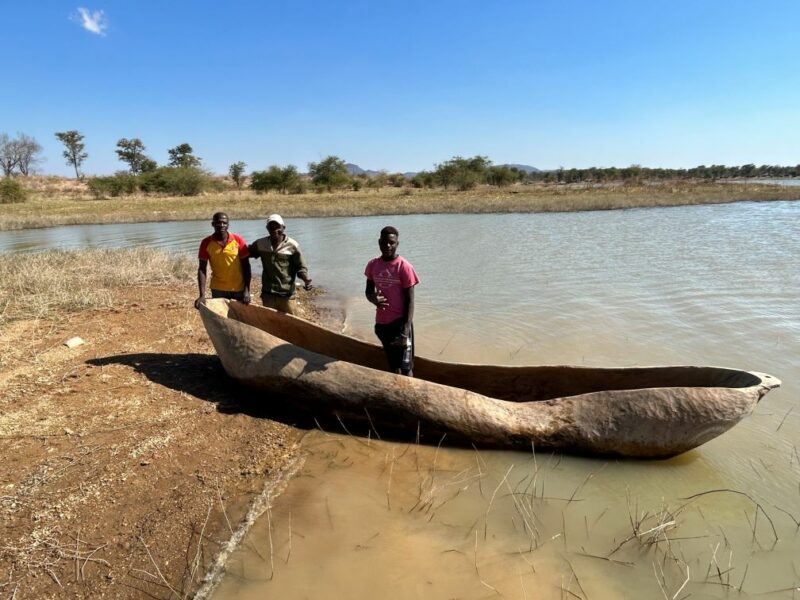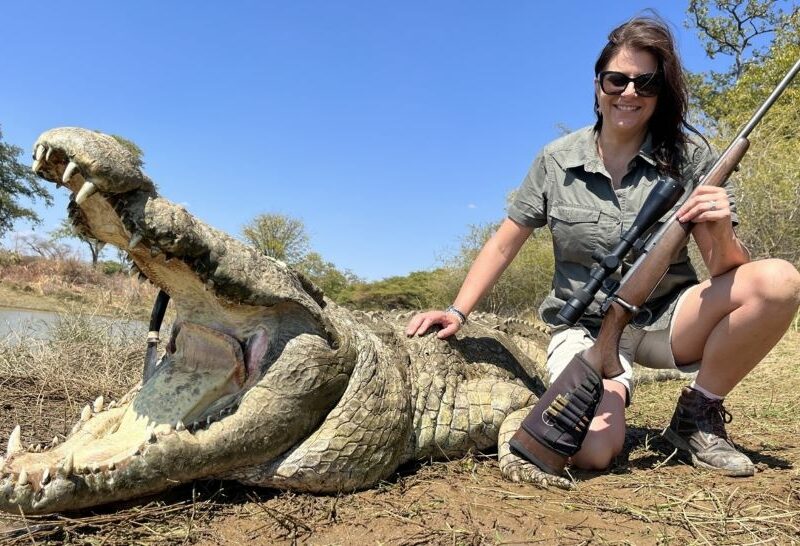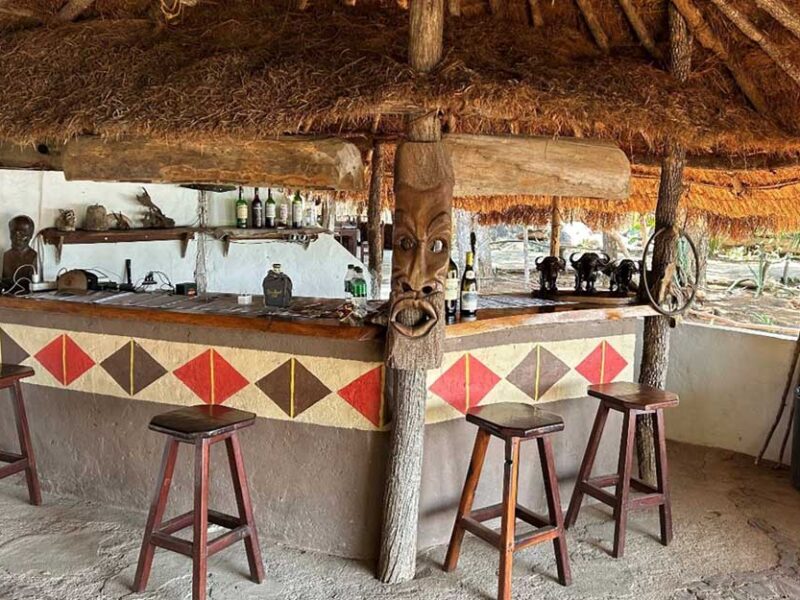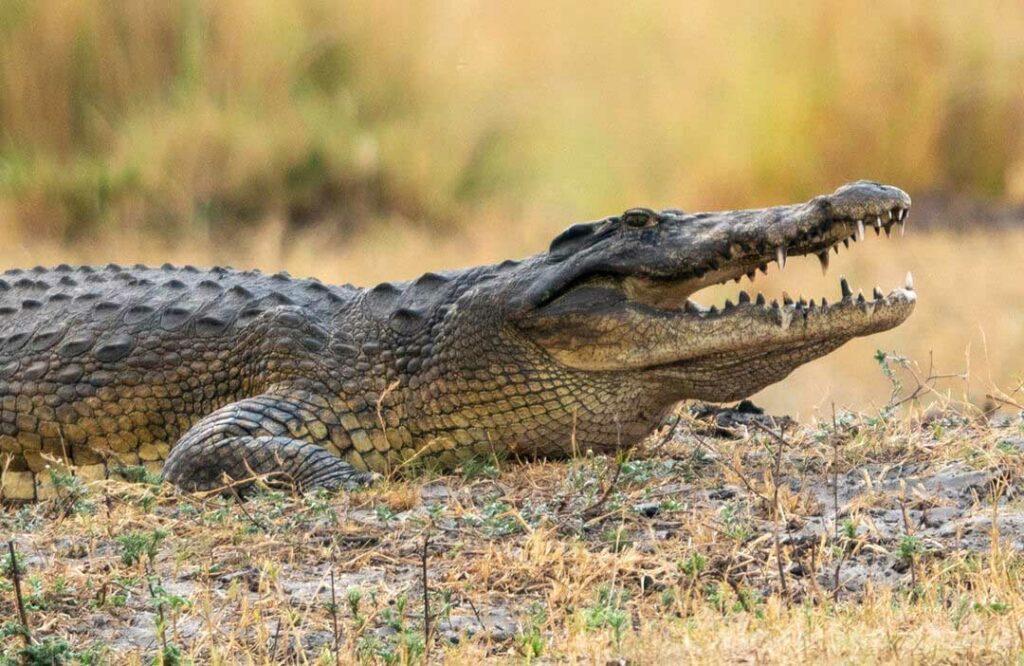Crocodiles, Scientific name (Crocodylidae).
Primitive Crocodile representatives, namely Protosuchia, made their first grand appearance 201,4 million years ago. They continued to evolve, and the “modern-day” crocodile appeared 60 million years ago, give or take a few. More than enough time to become the perfect apex predator, a challenge on any big game hunting safari.
Crocodiles, like all other reptiles, are diapsids.
[DYNAMIC-BLOGTABLEOFCONTENT]
What is a Diapsid?
A diapsid is a reptile that has two openings which are positioned on either side of its skull. A crocodile, just like a dinosaur, has a skull that has material upper jaw development. Low temporal fenestrae teeth, made biting, tearing, and ripping rise from these sockets.
Crocodile hunting in Africa is becoming a favorite African hunt within the international hunting communities. If an African hunting adventure is on the cards, crocodile hunting should most definitely be high up on the list.
Let’s have a look at the make-up and characteristics of the big game hunting opponent and quantify the crocodile’s arsenal of weapons and armor.
What Challenges will the Nile Crocodile bring to a Hunting Safari?
- This man-eating beast evolved before the part of the brain that processes imagination and feelings in animals evolved. So, basically when crocodile hunting, know the game hunting opponent has no remorse, is mindless, and is only focused on killing.
- If, while crocodile hunting, the crocodile manages to get a grasp on any part of the hunter, know that it has the strongest bite in all of the animal kingdom. If the crocodile loses a few teeth while tearing his opponent apart, this big trophy bull crocodile will not at all be concerned as his teeth regenerate.
- Crocodiles are speedy swimmers and can torpedo themselves at more than 22 miles per hour through water. Should the hunter fall out of mokoro while crocodile hunting, the odds will most certainly be against them.
- This big game hunting opponent has some serious body armor. A crocodile’s skin is nothing but a network of rock-hard scales varying in size. These scales, also known as scutes, are as hard as bone. Bony deposits called Osteoderms form on the scales making it almost impossible to penetrate the skin.
- Should the hunting safari be a success and the trophy crocodile is hung from a tree, the hunter needs to be very careful not to come into contact with any of the stomach contents. Enzymes in the stomach are very strong, almost like acid, and flesh, bones, cartilage, and sinew are rapidly digested. The stomach is also filled with some of the nastiest bacteria around and is to be avoided at all costs.
- When prepping for crocodile hunting in Africa, know that a crocodile’s brain is small and very well protected by a mass of thick and dense bone. Take this into account for rifle choice and shot placement.
- The safari hunter’s opponent is also equipped with sensory pits that cover the crocodile’s jaw. These pits enclose bundles of nerve fibers that can detect the slightest vibrations. So, not only will the crocodile hunt be a challenge as the adversary has exceptional hearing, but it will also be able to feel any movements made by the challenger.

Crocodile Hunting in Mozambique: Incredible, Rewarding, and Exhilarating!
My wife, Tamlyn, harvested the monster bull crocodile below, on the southern banks of Lake Cahora Basa. She used a Mauser 300 win-mag, with 180-grain monolithic tips. The crocodile bull measured a whopping 15,1 feet and weighed over 1,750 pounds!
Have a close look at the design of the webbed feet, the size of the teeth, and the scales on the upper body. As you will notice, this giant crocodile was definitely a few meals ahead of his comrades.
This crocodile’s age was estimated to be over 95 years old! This “tank” having survived numerous civil wars, could most certainly tell a few stories. While we had many a cold beer to celebrate this achievement, I am still annoyed that this crocodile measured bigger than mine, and I am reminded daily of that fact!

FAQs when Crocodile Hunting in Africa
What is the Rate for Crocodile Hunting?
A big game hunting safari for a giant Nile Crocodile will cost between US $ 10,000 and US $ 13,500, depending on the choice of African country as your game hunting destination. Crocodiles can be hunted in South Africa, Zambia, Zimbabwe, Namibia, Tanzania, and Mozambique.
Towards the end of the hunting season, many African outfitters may have extra tags or quotas left. Crocodile hunts often then get sold and marketed as a “discount hunt”. To take advantage of the discount hunt, know that often the hunter will have to travel at relatively short notice.
How are Crocodiles Hunted?
Crocodile hunting takes place using a variety of methods.
- Spot, walk, and stalk: On the embankments of rivers, estuaries, and swamps.
- Baiting: where your African outfitter will then construct a temporary blind.
Attempting a “kill shot” from a Mokoro is definitely not recommended!
What is the Best Caliber for Crocodile Hunting?
To successfully hunt a Nile crocodile, a high-powered rifle with sufficient muzzle energy is a requirement. Any thirty calibers (in my opinion excluding a .308), using a 180-grain monolithic bullet will work. The bullet needs to be able to smash through the very thick skull and penetrate the brain. A 300 win-mag loaded with a 220-grain bullet, or a .375 loaded with 300-grain is highly recommended.

Shot Placement: Where to aim when Crocodile Hunting
Crocodile hunting is no different than hunting any other animal species, whether it be African plains game, dangerous game, or specialty game, shot placement is critical.
In my opinion, successfully harvesting this beast via a brain shot, from the front or back is maybe not more difficult, but the pressure certainly is a lot more on this hunting safari.
The reality is that a crocodile’s brain, while hidden and protected by walls of thick bone, is between the size of a golf ball and a baseball. The problem is, that there is no room for any error whatsoever. A miss of an inch or two will result in the crocodile slithering back into the dark, swampy waters. If the crocodile is not anchored on the spot, any death convulsions may result in it rolling in the water, so it is indeed a challenging African hunt!
Read more about shot placement on a Nile crocodile.
Additional Challenges when Crocodile Hunting in Africa
Very often, the potential bull crocodile trophy will be lying with a large portion of its tail or its entire body in the water.
So, the hunter is lined up with a clean shot to the brain, the pivotal apex of the game hunting safari. Judging by the croc’s head, he looks huge. Surely this is the dream trophy crocodile. But what is happening with the body parts that remain in the water? Is the entire tail still there?
Often in the wild, crocodiles end up with missing body parts, from feet to tails, because of previous attacks. A 100-year-old crocodile has spent 36,500 days at risk occupying the same waterways where thousands of other crocodiles reside.
When measuring a trophy crocodile, it is measured from the tip of its snout to the tip of its tail. A crocodile missing a foot or two of its tail will make a great skull mount.
So, now we start throwing a little gambling into the hunting safari. To take, or not to take the shot! That is the question presented to the crocodile hunter on his Africa hunt.

I hunted the above crocodile in Mozambique. Mozambique is renowned for producing world-class crocodile trophies.
A Nile crocodile needs to measure 14 feet to be classified as a trophy crocodile using the Rowald Ward measuring system. This Crocodile came in at 14,9 feet (200mm smaller than Tamlyn’s). Luckily, no part of the tail was missing, quite unbelievable when considering the age. Per the SCI measuring system, a trophy crocodile has reached 9 feet and 7 inches.
Should I bring my own Rifle when Hunting Crocodile in Africa?
An African hunt for trophy crocodiles is only classified as successful when the monster crocodile is not only shot but successfully recovered and measured.
My suggestion would be if you are safari hunting in one only African country, pack your rifle. As crocodile shot placement is critical, it is important to be comfortable and familiar with your own rifle.
Traveling through multiple countries and arranging all the permits can result in additional admin. African outfitters have a good supply of high-quality rifles that the hunter may consider renting at a daily rate. It certainly can make an African hunt far more simplistic.
Crocodile Hunting and Why We Cannot Dispose of Them All
Besides a crocodile reptilian nature, these perfectly constructed killing machines add a great deal of value to the African environment.
If rotting animal carcasses were not devoured by crocodiles, bacteria released in the water systems would turn this valuable resource into pure poison. Local communities are tolerant of these predators as residents understand the value that they add to their lives, if of course, legally hunted and creating investment.
With crocodiles killing thousands of people every year, I think it can be assumed that every crocodile over a certain age can be classified as a potential man-eater. Harvesting a trophy crocodile can only bring joy in local communities, where the death of friends, family, and children can be avenged.
When crocodile hunting in Mozambique, we were advised by our outfitter that skinners refuse to cut open the bellies of the trophy crocodile as it is soul-destroying to continually find skulls, shoes, and body parts inside, and that I can well believe.
Accommodation while Crocodile Hunting in Africa
As big game hunting safaris take the hunter to remote corners of the “Dark Continent” African outfitters provide basic but adequate lodges.
The beds will be comfortable, the local cuisine fantastic and the beverages will always be cold with plenty of ice available. Just check the local cell phone and data signal and confirm that the outfitter has an emergency satellite phone. If you are like us African folk and enjoy beer, advise the outfitter to please “stock up!”
Accommodation throughout Africa will always vary. On a previous safari, we went hippo hunting in Namibia, in the famous Caprivi Strip. That area of the world has enormous populations of crocodiles. Accommodation in that area was in the form of three-star tents, which were exceptionally comfortable.
Your booking broker can always assist with providing images of the African lodges before the commencement of the crocodile hunting safari.
The below image is typical of what can be expected when crocodile hunting in Mozambique. Very rustic, with the theme being carried through the hunting lodge.

Targeting Man-Eating Beasts
A dangerous game hunting safari in Africa has to, of course, include man-eating beasts. It really is a good sense of accomplishment to harvest a trophy Nile crocodile.
Read more about Tamlyn’s 15,1ft monster crocodile hunting safari or discover more about the untamed safari hunting destinations to hunt crocodiles in Africa.
Author: P.C. van Wyk
